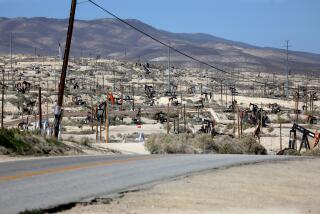Charles Schreiner III; Rancher Helped Save the Texas Longhorn
Charles âCharlie Threeâ Schreiner III, a bona fide cowboy who had the business savvy of Bernard Baruch, the showmanship of P.T. Barnum and the Texas pride of Sam Houston, has died. He was 74.
Charlie Three, who rescued from near-oblivion the fabled Texas longhorn that roamed the range in his granddaddyâs day, then rescued his familyâs Y.O. Ranch from near-bankruptcy by stocking exotic animals and offering both hunters and photographers a chance to shoot them, died April 22 in a San Antonio hospital of congestive heart failure.
His ranch, shrunk to 50,000 acres from the 500,000 his grandfather amassed, but still in the family and thriving, is near Mountain Home, Texas, about 100 miles northwest of San Antonio.
The cattle baron once described as a âstocky, round-faced man with a grizzled mustache who looks like a hammered-down Hemingway,â started life as an only child whose father died before he turned 6. He grew up on the Y.O., tutored by his âtough and elegantâ rancher mother, Myrtle, and the working cowboys.
He developed into a history buff with a business degree from the University of Texas (where the football team is called the Longhorns), and amassed a library of cattle country lore and a $1-million collection of vintage Colt pistols, all secured behind a bank vault door in the rambling stone-and-cedar ranch house overlooking his 100-square-mile spread.
His immigrant grandfather, Capt. Charles Schreiner, a Texas Ranger at 16 who later fought with the Confederates in the Civil War, founded the ranch on 25-cent-per-acre land in 1880 and stocked it with the highly profitable longhorn. The patriarch named his land the Y.O. Ranch for the brand he seared into the cattleâs flanks.
Sometimes considered Americaâs only ânativeâ breed of cattle, the lean, lanky animals actually originated in Spain. Longhorns were first brought to the Americas in 1493 on Columbusâ second voyage. They were introduced in the Southwest in 1521 by Spaniard Gregorio de Villalobos.
Adapting well to Texasâ arid, rough terrain, the cattle resisted disease, thrived on little water and grass, and calved easily. They stood 6 feet tall, weighed a lean 800 pounds (modern counterparts are closer to 2,000 pounds) and boasted horn spreads as wide as 9 feet. They produced low-fat, low-cholesterol beef long before Americans needed it.
Speedy on their strong, thin legs, the animals were herded--as many as 600,000 annually in the 1880s--to markets in Abilene and Dodge City, Kan., along the Chisholm Trail. They became a part of cowboy lore and were to 19th century Texans what buffalo were to Indians--a supply of meat, hides and income.
In 1865, longhorns ranged in the millions and were said to outnumber Texans 9 to 1. But within half a century, the animals had dwindled to fewer than 100, some historians estimate, and were closer to extinction than the buffalo.
As Americans grew wealthier, their taste buds craved better-marbled steaks. So longhorns were crossbred with fatter European Herefords and Black Angus, almost to oblivion.
By the 1920s, when federal conservationists established the Wichita Wildlife Refuge at Cash, Okla., they found only 30 animals to nurture there that still qualified as purebred Texas longhorns.
Inheriting the family ranch, which by then was raising fatter beef cattle and sheep, in 1949, Charlie Schreiner was immediately beset by a seven-year drought. By 1957, the imaginative rancher had a couple of ideas to save the Y.O. financially. One involved the Texas longhorn.
âIâd always been an incurable romantic about the longhorn and read just about everything published on him,â he said in 1976. âThen the terrible drought made me think about actually utilizing him. We lost a lot of cattle in the drought, and I thought of the practicality of the longhorn, how hardy and disease-resistant he was.â
Schreiner bought six heifers and a bull from the Oklahoma preserve at $80 each. Although his growing herd remained less valuable for its meat than for its nostalgic appeal and use in Western films, within three decades the price of each Y.O. longhorn rose to $2,400.
In 1964, encouraged by other ranchers who wanted to preserve the colorful breed, Schreiner founded the Texas Longhorn Breedersâ Assn. of America and served as its first president. He built his own herd to more than 1,000, one of the largest in the nation. It now has more than 250,000 of the prized cattle.
Schreinerâs second post-drought moneymaking scheme helped pioneer another Texas phenomenon--the importation of exotic animals, or âTexotics,â to the Hill Country.
The Y.O. involvement came about in 1957 when a ranch visitor saw a blackbuck antelope that Schreiner had gotten as surplus from the San Antonio Zoo. How much would it cost to hunt it, he wanted to know. Schreiner, deep in debt, suggested $125. Done, said the visitor. Soon Schreiner was charging hunters to stalk native white-tailed deer and wild turkey and importing foreign varieties of game.
By 1967, Schreiner had worked to establish the Exotic Wildlife Assn., and more than 600 ranches, including the Y.O., now stock and breed various species to entertain paying hunters and tourists and to replenish diminishing numbers of the animals in their native habitats.
In 1965, Schreiner started an annual trail drive, just like his granddaddy used to run to get the longhorns to market. This yearâs event is scheduled for Memorial Day weekend with an 1880s costume party. Participation costs $200 per person, plus horse rental.
Knowing every Texan longs to be a rancher, Schreiner sold off 100-acre chunks of his land to shareholders who were invited to enjoy the entire Y.O. and its tourist amenities.
The Barnum in Schreinerâs soul continually devised new ways to attract those paying visitors and lots of attention. He invited guests to dine at his ranch restaurant and then, for example, shoot machine guns at a gasoline-filled car until it exploded.
When the ranch turned 100 in 1980, he invited 2,600 guests, who arrived by private plane, limousine and pickup truck, to a black-tie-and-boots ball. Charlie Three rode in on Ranger, his pet longhorn. Then he loaded up his Gatling gun and fired several rounds. When the ranch turned 110, he hired Willie Nelson to entertain.
Widowed in 1988, the thrice-married Schreiner lost one of his four sons, Louis, to a heart attack on Easter. He is survived by the other three, Charles IV (known as âCharlie Fourâ), Walter and Gus; and nine grandchildren, including âCharlie Five.â
More to Read
Sign up for The Wild
Weâll help you find the best places to hike, bike and run, as well as the perfect silent spots for meditation and yoga.
You may occasionally receive promotional content from the Los Angeles Times.






